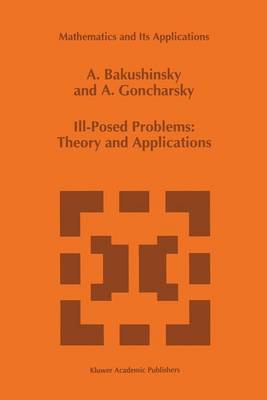Mathematics and Its Applications
2 primary works
Book 301
Ill-Posed Problems: Theory and Applications
by A. Bakushinsky and A. Goncharsky
Published 30 September 1994
Recent years have been characterized by the increasing amountofpublications in the field ofso-called ill-posed problems. This is easilyunderstandable because we observe the rapid progress of a relatively young branch ofmathematics, ofwhich the first results date back to about 30 years ago. By now, impressive results have been achieved both in the theory ofsolving ill-posed problems and in the applicationsofalgorithms using modem computers. To mention just one field, one can name the computer tomography which could not possibly have been developed without modem tools for solving ill-posed problems. When writing this book, the authors tried to define the place and role of ill posed problems in modem mathematics. In a few words, we define the theory of ill-posed problems as the theory of approximating functions with approximately given arguments in functional spaces. The difference between well-posed and ill posed problems is concerned with the fact that the latter are associated with discontinuous functions. This approach is followed by the authors throughout the whole book. We hope that the theoretical results will be of interest to researchers working in approximation theory and functional analysis. As for particular algorithms for solving ill-posed problems, the authors paid general attention to the principles ofconstructing such algorithms as the methods for approximating discontinuous functions with approximately specified arguments. In this way it proved possible to define the limits of applicability of regularization techniques.
Book 328
Numerical Methods for the Solution of Ill-Posed Problems
by A N Tikhonov, A. Goncharsky, V. V. Stepanov, and Anatoly G. Yagola
Published 30 June 1995
Many problems in science, technology and engineering are posed in the form of operator equations of the first kind, with the operator and RHS approximately known. But such problems often turn out to be ill-posed, having no solution, or a non-unique solution, and/or an unstable solution. Non-existence and non-uniqueness can usually be overcome by settling for `generalised' solutions, leading to the need to develop regularising algorithms.
The theory of ill-posed problems has advanced greatly since A. N. Tikhonov laid its foundations, the Russian original of this book (1990) rapidly becoming a classical monograph on the topic. The present edition has been completely updated to consider linear ill-posed problems with or without a priori constraints (non-negativity, monotonicity, convexity, etc.).
Besides the theoretical material, the book also contains a FORTRAN program library.
Audience: Postgraduate students of physics, mathematics, chemistry, economics, engineering. Engineers and scientists interested in data processing and the theory of ill-posed problems.
The theory of ill-posed problems has advanced greatly since A. N. Tikhonov laid its foundations, the Russian original of this book (1990) rapidly becoming a classical monograph on the topic. The present edition has been completely updated to consider linear ill-posed problems with or without a priori constraints (non-negativity, monotonicity, convexity, etc.).
Besides the theoretical material, the book also contains a FORTRAN program library.
Audience: Postgraduate students of physics, mathematics, chemistry, economics, engineering. Engineers and scientists interested in data processing and the theory of ill-posed problems.

